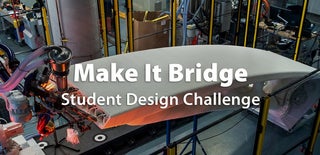Introduction: Wildlife Overpass
Hello everyone, I'm Youjia, attending 11th grade at Piedmont Hills High School. I'm a self-taught CAD user and Instructables helped me a lot in learning more about the field of engineering.
----------------------------------------------------------------------------------------------------------------------------------
Animal collisions with vehicles take the lives of countless animals every year. These incidents cost a lot of money for vehicle repair, highway cleanup, and may even result in injuries of drivers and/or passengers.
----------------------------------------------------------------------------------------------------------------------------------
The solution?
Overpasses specifically made for land-based creatures that allows them to pass from one side of a road to the other. These should be built at particular vantage points for the animals, as well as added fencing along the highway to herd the animals towards the bridge. Cameras can be installed to capture wildlife footage in order to determine the impact the overpass is extenuating. Plus, these bridges often promote sustainable design in order to lower costs and make it more appealing to secure funding these large projects.
Supplies
Some helpful software
- Apple Maps
- Google Earth
- Procreate
----------------------------------------------------------------------------------------------------------------------------------
Here are the things I used to make my prototype
- Fusion 360
- Creality Slicer
- Ender-3 Max Neo Printer
- White PLA filament
----------------------------------------------------------------------------------------------------------------------------------
Other miscellaneous materials:
- Cardboard
- Hot glue
- Soil/dirt
Step 1: Finding a Highway
Since I live in California, I want to propose a solution to fix existing animal collisions problems in California.
----------------------------------------------------------------------------------------------------------------------------------
According to this article, Interstate 280 between San Bruno and Cupertino, the California Highway Patrol reported more than 44,000 wildlife collisions involving large mammals across the state between 2016 and 2020, which cost around $5.8 million annually. Large mammals like mountain lions, bears, bighorn sheep (endangered) are affected, as well as other animals such squirrels, birds, and pacific newts (endangered).
Step 2: Why Are Animals Crossing?
You may be asking, why are animals crossing the highways?
Because the highways cut across their natural habitats, which leads to several problems:
- Lower genetic variation because of the population division (less mates)
- Food shortages
- Disrupted traditional migration routes
- Threatening endangered species
Therefore, the overpasses would solve all these issues, as it provides animals a safe option.
(video source link)
----------------------------------------------------------------------------------------------------------------------------------
By understanding why animals cross highways, I was able to better deduce a vantage point in which an overpass can is most effective for wildlife.
Step 3: Choosing the Vantage Point
Looking at the image, I chose a spot along I-280 that was near Redwood City (circled).
I chose it because the highway clearly cut through animal habitat, with mountains and forests on either sides of it (shown by the boxes I drew). There is also the Crystal Springs Reserve, which could possibly be a migration destination for Pacific newts, an endangered species.
Step 4: Measurements
Next, using the "measure" tool in Google Earth, I was able to take measurements of the road.
Step 5: Drawing With Measurements
I drew a mockup (using Procreate) so that it was easier to understand and think of ideas.
Step 6: Bridge Design Inspiration
I researched options for bridge design, as well as existing wildlife overpasses for inspiration.
Step 7: Brainstorming Designs
I chose to draw some of the most simple designs, because simple solutions are usually the best.
----------------------------------------------------------------------------------------------------------------------------------
Also, since the animals I'm targeting are mountain lions, bears, bighorn sheep (endangered), squirrels, birds, and pacific newts (endangered), these bridge designs are the ones I thought to be able to withstand its own weight (because the width needed to be 50 m) and having trees planted on top.
Step 8: Other Details
The standard height of overpasses along highways should be 5.2 meters tall.
The width of overpasses should be between 50-70 meters.
Step 9: CAD Modeling
The first image is the assembly of the two other images. (I used Fusion360 for this step)
The bridge is essentially a frame that acts like a skeleton to supports all the soil, dirt, and gravel that will be put into the bridge.
----------------------------------------------------------------------------------------------------------------------------------
I chose this design because it had multiple points of drainage so that the water can flow freely instead of just sitting on the bridge, adding weight to the soil. Because it seemed to use more material than the other bridges, I tried to make most of the bridge out of soil, leaving large amounts of empty space so that the bridge will use less material, which is a more sustainable design.
----------------------------------------------------------------------------------------------------------------------------------
(The scale of the CAD design is 10.28m : 1cm, that is probably not the proper way to write it...But basically, take the real-life measurements [which are in meters] and convert it to centimeters using the ratio)
Step 10: Print and Assemble Prototype
Summary of the print: it took 2.5 hours and used 5.5 m of filament.
----------------------------------------------------------------------------------------------------------------------------------
I used hot glue to put the model together, and I also used a strip of cardboard to put the model upon.
Then I put dirt in the bridge. Pretty self-explanatory.
Step 11: An Optional Test
I wanted to test out if this bridge can actually grow native vegetation, so I sprinkled some native plant seeds that I got from my awesome local library and watered it. It was a rather messy process.
I'll edit in an update when something changes.
Step 12: Conclusion
Thank you for taking the time to read through all of this :)
I put a lot of time into researching and designing this overpass which I think can solve a really important issue that is occurring all over the globe as urbanization continues to expand. One of the reasons why wildlife overpasses are not being built is because of the lack of funding, and I hope that my project would inspire some more sustainable structures that can lower costs.
Step 13: Extra Image - Thumbnail
This is what I'd imagine the optimal situation to be like :D

Runner Up in the
Make It Bridge
















